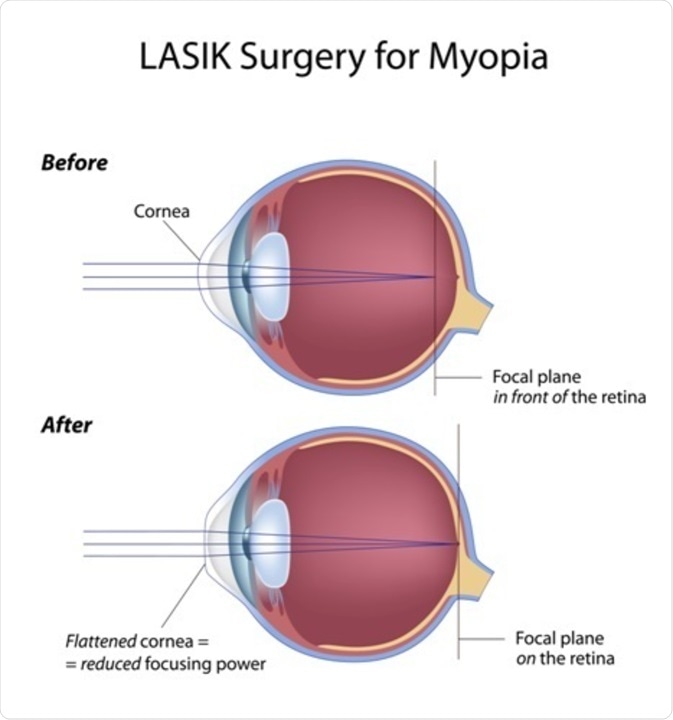Laser in situ keratomileusis (LASIK) is a popular surgery for refractive vision correction where the cornea of the eye is reshaped by a laser. A convergence of numerous brilliant ideas and bioengineering accomplishments gave birth to this method, which undoubtedly represents one of the most efficient procedures in the history of medicine. Therefore LASIK is a common form of corrective surgery today and thousands of patients have benefited from the procedure.

Image Credit: Alila Medical Media / Shutterstock
Keratomileusis and excimer laser
The concept of correcting refractive errors by sculpting corneal stromal tissue in order to change corneal curvature was the original idea of José Ignacio Barraquer Moner in 1948. He developed a procedure named keratomileusis (literally translated as the sculpting of the cornea) which involved resecting a disc of anterior corneal tissue and flattening the anterior corneal curvature, reducing, in turn, the refractive power of the eye.
He used a manually driven microkeratome and his first patients were treated in the early 1960s at the Clinica de Marly in Bogota, Colombia. It was a unique operation in the sense that a piece of the organ was removed, modified and then replaced in its original position. Also, for the first time, a computer was used to determine the amount of the required surgery.
During further refinement of his keratomileusis procedure, Barraquer invented a number of instruments and techniques which helped to turn his ideas into a reality. His inventions included the operating microscope, torque anti-torque suture and panoply of other microsurgical instruments that ophthalmologists use in today's daily practice.
Others were also experimenting with similar ideas around that time. In 1964, Polish physician Krwawicz described a series of three highly myopic eyes in which he had made two stromal cuts at different depths using a flat knife, and removed the thin lamella of the intervening stroma. In Russia, Pureskin described the concept of an incomplete anterior corneal resection in 1967.
In the 1980s technique called in situ keratomileusis was developed and first performed by Ruiz. He came up with the idea of passing the microkeratome a second time using a different suction ring with adjusted height in order to resect the required lenticule directly from a stromal bed.
One thing missing for LASIK to become the technology we are familiarized with today was an adequate laser. In 1970, the term excimer laser was coined to describe a laser built by Basov using a xenon dimer gas; hence the name excimer comes from an abbreviation of “excited dimer”.
Laser eye techniques were starting to appear, and photorefractive keratectomy was recognized as the first successful corrective eye surgery which uses a laser instead of a blade. In this technique, the entire outer epithelial (outer) layer of the cornea is removed to expose the area and no flap is created; excimer laser then sculpts the stromal layer of the cornea to correct the refractive error in question. It is still performed today as it offers several advantages over LASIK for certain patients.
The emergence of LASIK
At this point, the excimer laser joined the keratomileusis to become laser in situ keratomileusis – or LASIK. The idea of using an excimer laser for ablation of the tissue under a hinged flap was emerging simultaneously in various parts of the world.
In 1990, a Greek physician Ioannis Pallikaris was first to create a flap of tissue with the microkeratome he had designed for rabbit studies and performed the ablation with an excimer laser on the exposed bed, followed by replacement of the flap without sutures. The term LASIK was first used to describe this procedure in the paper he published in 1990.
The technique was not formally approved by the American Food and Drug Administration (FDA) until 1999, but today a wide range of advances make the procedure simpler and safer. Modern microkeratomes enable surgeons to customize flaps for each individual eye with the use of variable head and ring sizes, as well as different hinge positions.
LASIK quickly gained a lot of popularity in a short period of time, as it provided immediate improvements in vision with much less pain and discomfort when compared to the photorefractive keratectomy. In recent years methods of flap creation have changed due to the evolution of the mechanical microkeratome and the introduction of femtosecond laser keratome and wavefront technology.
Sources
- http://umm.edu/health/medical/ency/articles/lasik-eye-surgery
- https://www.aao.org/
- Boyd BF. Modern Ophthalmology - The Highlights: The Account of a Master Witnessing a 60 Year of Evolution and Progress, 1950-2010. JP Medical Ltd, 2011; pp. 327-339.
- Azar DT, Koch D. LASIK (Laser in Situ Keratomileusis): Fundamentals, Surgical Techniques, and Complications. CRC Press, 2002; pp. 21-38.
Further Reading
Last Updated: Feb 24, 2023